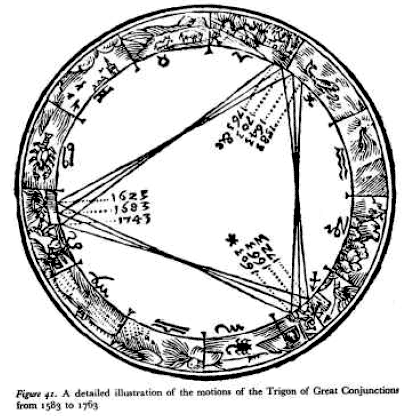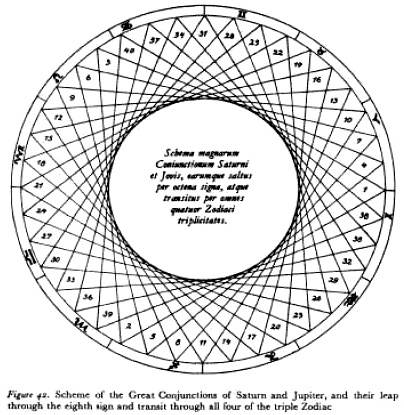|
APPENDIX III
The Sigui ceremony of the Dogon is celebrated every sixty years.
What precedents for such a period of time, given religious
importance, are to be found in the ancient world?
And this period is described in a Hymn to Osiris:2
The henti period may, by pun, have had some association with the
phallus, henn. I only suggest this because of the connection of
circumcision with the Sigui ceremonies of the Dogon. It is pure
speculation. Henti is also a title of Osiris, presumably arising
from the fact that the duration of Osiris's existence is said to be
'an eternal henti period'.
Sixty years is
the great period which brings into synchronization the movements of
the two great outer planets which can be seen by the eye. I have no
doubt that this sixty-year period has been of considerable
importance in ancient times, and the sharp-eyed Egyptians would have
been well aware of it.
These observations of Olympiodorus, from his Commentary on Plato's Gorgias in the form of scholia, are cited by Thomas Taylor as comment on a passage by Apuleius (best known as author of The Golden Ass) in one of his Platonic essays:4
This esoteric cycle conjoining the motions of Saturn and Jupiter would have seemed of immense importance to all ancient astronomers who had a good grasp of their subject. A cycle of sixty years is so long that no single person can live long enough to verify its recurrence a second time. The knowledge of such a cycle required a continuing tradition of observation which implies a priesthood with astronomical inclinations.
The discovery and verification over more than one generation of an esoteric cycle joining the two great outer planets would appear as exciting to the ancient priests as discovering DNA has been to modern biochemists. To 'crack' the mysteries of the motions of the two outer planets is quite an achievement. No wonder, then, that the Dogon maintain that a priest who 'united two Sigui' is really rather special.
Apart from the fact that no one lives 120 years very easily, and thus 'uniting two Sigui' is accepted as having celebrated two Sigui ceremonies in a lifetime, the reduplication of the cycle may be taken to signify that only by checking to see if it happens a second time can the cycle be verified.
To unite two of the cycles is to achieve a henti, which we
have just seen the Egyptians describe both as 120 years and as
'eternal'. How can 120 years be 'eternity'? This can be so when
eternity is seen to consist of a cyclical construction. In other
words, eternity is not a straight line to infinity but is rather an
endless series of coils of the same size compressed into a great
spring, known as time, and with the impetus of happening.
Then we read:
The author later adds:7
Later the author adds:
Passing beyond our quaint old source book, we may investigate this
rumored Indian cycle of Vrihaspati. We soon discover that it does
indeed exist in Indian tradition, where it is more properly known as
that of Brihaspati. The name Brihaspati (or Vrihaspati) is the name
of the planet Jupiter in Sanskrit, and the cycle which takes its
name from this planet is a 6o-year cycle.
For
it is by means of a particular astrological diagram that one
traditionally computes the relative positions of Saturn and Jupiter.
I reproduce two such diagrams in Figures 41 and 42. These diagrams
were prepared by Johannes Kepler, discoverer of our three laws of
Planetary Motion, and whom I discussed slightly in Appendix I.10
And further:
And this trigon must be
diagrammatically presented.
See also Figures 41 and 42 for the diagrams by which Saturn gives
the (temporal) measures of creation to Jupiter. There is a Great
Conjunction of Jupiter and Saturn every twenty years, as the
diagrams show. The Dogon seem to be aware of the 20-year subdivision
of the 60-year period too. If the reader turns back to the Griaule
and Dieterlen article which follows Chapter One of this book, and
studies Figure ii accompanying that article, as well as the text
referring to it, he will see that the Sigui 60-year computation is
broken down into 20-year segments.
Figure xii of the Griaule and Dieterlen article in this book records the 'mutilating domination of Sirius over the femininity of Yasigui'.
In Le Renard Pale one reads a great deal about genital mutilation, castration, circumcisions, female circumcisions, and so on. These strange conceptions of genital violence associated symbolically to heavenly movements obviously came to the Dogon along with the rest of their ancient traditions, and survive as well in the Mediterranean region indigenously.
The mutilation of Saturn by Jupiter, and the various creations which sprang from the resulting blood and seed, are of the same current of tradition as all the elements of a similar kind to be found among the Dogon, and which are related to these comparative orbitings of Saturn and Jupiter, as well as other heavenly bodies.
The placenta comes back into the picture too. We have seen in the main text of the book that the placenta is the symbol; for the Dogon, of a planetary system, and the system of our sun and its planets is a placenta. It is therefore interesting that the Dogon say that 60 is the count of the cosmic placenta.15
For this specifically identifies the 60 years as a count defining our planetary system, define our cosmic placenta, our solar system, for them.
The Dogon even break 60 down themselves into '5 series of 12'16 and twice thirty, which seems a fairly specific indication that our hypothesis has a sound basis. For the last point, the drawing above the door of the Dogon sanctuary of Binou17 reinforces these ideas. This drawing is used for the computation of the Sigui. Accompanying this drawing is a drawing of the Nommo which is broken down into two major portions: his right 'leg' marks the first thirty years and his left 'leg the second thirty years.
The legs are joined to represent that only taken together do these two thirty-year periods have significance. And, as we know, Nommo did not actually have legs. He had a fish-tail extremity.
The fact that each 'leg' represents a period of years is made quite clear by the information given that,
This process recalls Plutarch's remark, noted much earlier in the book, that Zeus (Jupiter) had his legs joined together. In short, Jupiter's legs were joined together because each of his 'legs' represented one of the thirty-year orbital periods of his father Saturn, and it was on his father that he stood. For Saturn upheld Jupiter's creation by providing him with the temporal measures, as Santillana and von Dechend explain.18
And the Dogon are the people who preserve this intricate tradition most fully, which should not surprise us. They say that 60 is the 'number of the placenta', and indeed it is. Without 60 we could not define our solar system according to the traditional view of it - and this traditional view is the one resting on the capabilities of observation, which is sensible.
For us to define our system today by saying it is bounded by the motions of a tiny body called Pluto doesn't mean anything to anybody. For us to ground ourselves in the weighty and ponderous motions of those two observable planets Saturn and Jupiter, and define our solar system - perhaps 'poetically' - by their motions as extremities, we would be striking a deep chord in that music of the spheres of which we have all heard fanciful tales, but of which today we know nothing.
But music which cannot be heard is not necessarily lost to the inner ear. Music, after all, is not necessarily audible sound. Harmony transcends the sensibly perceptive. The observance of a celestial harmony in the ancient cultures helped keep a sane perspective. To acknowledge the deep resounding bass of the 60-year cycle was the ultimate poetic myth of the solar system, expressed in that vast mythological fabric woven around all the heavenly bodies, a whole cloth binding together both man and planets in a cosmic unity which gave man dignity and meaning in a world whose periods and cycles he had defined and celebrated in his religious festivals.
Even today we do this, but have lost consciousness of it; Easter is defined by the moon. But who notices that? The cosmic bodies make their silent music but we have stopped our ears. We do not wish to be integrally related to our cosmic environment by observances of the great motions above us.
All the reader need do is to take the cotton wool out of his ears and listen. He will hear silence. And the cycles and periods of that silence are the beautiful music of the cosmos.
But as long as we keep our ears stopped, we will be deafened by our inner noise and will have those tortured 'modern' looks on our faces.
|

